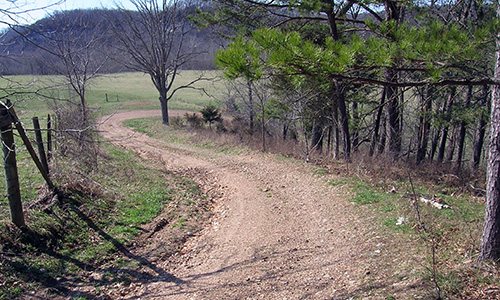Maintaining farm roads and driveways saves you time and money, says University of Missouri Extension specialist Bob Schultheis.
“Probably the most used and abused parts of any farm are the driveway and access roads. A well-designed road will last a long time,” Schultheis says.
Water is a road’s main enemy. “Water causes more damage to roads than poor materials, heavy traffic or adverse weather conditions,” Schultheis says.
He shares 10 “commandments” to keep farm roads in good condition.
1. Get water away from the road. A good surface drainage system has four main parts: road crown, shoulders, ditches, and culverts. The crown and shoulders stop infiltration into the road surface by diverting the water to the ditches. Ditches and culverts steer water away from the roadway to prevent damage to the road base. Keep them clean and protect them from erosion.
2. Build a firm foundation. A roadway wears out from the top, but it falls apart from the bottom. Use materials that form a stable foundation and do not settle when wet. Choose materials that hold up under repeated loads when the road is wet or dry.
3. Use the best soils available. The adage “pay me now or pay me later” applies here. The quality of soils used often depends on local availability and cost. Don’t cut corners by using inferior base material that will need costly maintenance and repair during the road’s life.
4. Compact soils well. The denser the material, the stronger it is. Well-graded soils with an even distribution of particle sizes compact better than soils made of particles of uniform size. Crushed or angular particles compact better than rounded particles of the same size. Soils should be moist for best compaction. Compact with a sheepsfoot roller or rubber-tired equipment. This works better than a bulldozer.
5. Design for winter maintenance. Make ditches wide enough to store snowfall and handle spring thaws and heavy water flow. Use a minimum of 1 percent grade for drainage purposes, and no more than 10 percent grade to allow easier maneuvering of vehicles. Consider safety in the road design. Drivers should be able to see 75 to 100 feet up the road for every 10 mph of speed.
6. Build for traffic loads and volumes. A rule of thumb is to design the road for the largest vehicle that will use it under normal operations. A good all-weather farm road can be made using a mixture of ¾- to 3-inch crushed stone laid down in two 6-inch layers, and topped with a 4-inch layer of “bank-run” gravel, ½- to 1-inch crushed stone or limestone screenings. Wet and pack each layer with a wheel tractor or other heavy-wheeled vehicle.
7. Pave only well-built roads. Don’t pave dirt or gravel roads just to get rid of dust problems. You’ll waste your money unless the road is built well and drains well before paving.
8. Build from the bottom up. You can’t improve a road with a poor base and poor drainage by adding a top dressing of gravel or new pavement. Geotextile fabric installed under the base can stabilize persistently wet spots or high-traffic roads.
9. Protect your investment. Roads need regular maintenance to keep them from falling apart. Maintenance includes blading, shaping and patching the road surface; cleaning and repairing ditches and culverts; cutting brush, trees and grass along the road; and repair of roadside erosion.
10. Keep good records. Recording the date and type of repair, and what materials were used can help in making sound decisions later.







